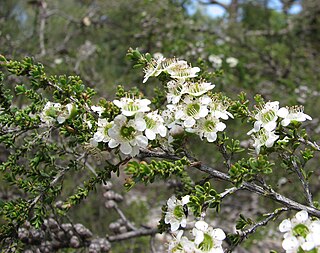
Leptospermum liversidgei, commonly known as the olive tea-tree, is a species of compact shrub that is endemic to eastern Australia. It has narrow egg-shaped, lemon-scented leaves, white or pink flowers and woody fruit that remain on the plant at maturity.

Gaudium trinervium, commonly known as flaky-barked tea-tree, slender tea-tree or paperbark tree, is a species of shrub or small tree that is endemic to eastern Australia. It has papery bark that is shed in thin, flaking layers, narrow elliptic to broadly egg-shaped leaves with the narrower at the base, white flowers and silky-hairy fruit that falls from the plant when mature.

Gaudium jingera, commonly known as the stringybark tea-tree, is a species of shrub that is endemic to Victoria, Australia. It has papery bark on the larger branches, smooth bark on the younger stems, narrow egg-shaped to elliptical leaves, white flowers and silky-hairy, hemispherical fruit.
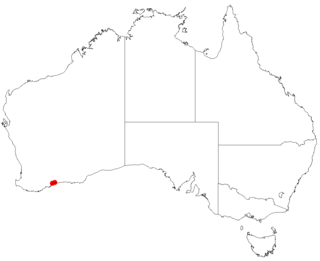
Gaudium confertum is a species of shrub that is endemic to East Mount Barren on the south coast of Western Australia. It has rough bark, crowded narrow club-shaped leaves and white flowers that are pinkish in bud.

Gaudium coriaceum, commonly known as green tea-tree or mallee teatree, is a shrub species that is endemic to south-eastern and south-central Australia. It has smooth bark on the younger stems, elliptic to narrow egg-shaped leaves, white flowers and woody fruit. The usual habitat is mallee on sand dunes.

Gaudium multicaule, commonly known as the silver tea-tree, is a species of shrub that is endemic to south eastern Australia. It has linear, narrow elliptical or narrow egg-shaped leaves, white or pink flowers usually borne singly on short side shoots, and fruit the falls from the plant soon after the seeds are released.

Gaudium parvifolium, commonly known as lemon-scented tea-tree, is a species of shrub that is endemic to eastern Australia. It has thin, rough bark, egg-shaped leaves with the narrower end towards the base, white or pink flowers, and fruit with the remains of the sepals attached but that is shed when the seeds are mature.

Gaudium deanei, commonly known as Deane's tea-tree, is a species of rare, slender shrub that is endemic to the northern suburbs of Sydney. It has bark peeling in long strips from the older stems, hairy young stems, narrow elliptical to lance-shaped leaves, white flowers arranged singly on short side shoots and mostly glabrous fruit.

Gaudium blakelyi is a species of shrub that is endemic to rocky clifftops near Lithgow in New South Wales. It has densely silky young stems, egg-shaped to elliptical leaves and white or pink flowers.

Gaudium brevipes, commonly known as the slender tea-tree, is a species of shrub or small tree that is endemic to eastern Australia. It has fibrous bark on the main stems, smooth bark on young stems, narrow elliptical to narrow egg-shaped leaves, white flowers and hemispherical fruit that is shed when mature.

Gaudium divaricatum is a species of plant that is endemic to inland New South Wales. It is an erect or weeping shrub with compact fibrous bark, elliptical to egg-shaped leaves, white flowers arranged singly on short axillary side shoots and woody fruit that fall off when mature.
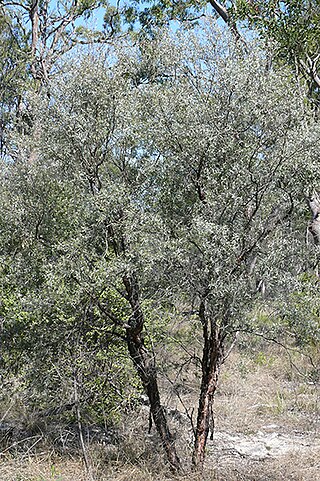
Gaudium lamellatum is a species of shrub or small tree that is endemic to inland Queensland and has distinctive reddish, layered bark. It has narrow elliptical leaves, white flowers and small fruit that fall from the plant when mature.
Gaudium microcarpum is a species of shrub that is endemic to eastern Australia. It has elliptical to lance-shaped leaves with a sharp point on the tip, white flowers and small fruit that falls from the plant shortly after the seeds are released.

Gaudium namadgiense is a species of small shrub that is endemic to areas near the border between New South Wales and the Australian Capital Territory. It has silky-hairy, narrow lance-shaped to elliptical leaves, usually white flowers borne singly or in pairs on short side shoots, and fruit that falls from the plant shortly after the seeds are released.
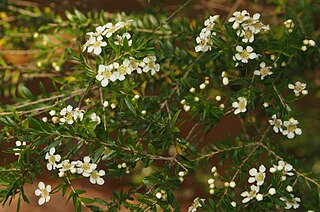
Leptospermum neglectum is a shrub or small tree that is endemic to Queensland. It has elliptical leaves that are silky-hairy at first, white flowers on short shoots in leaf axils and fruit with the remnants of the sepals attached but that fall from the plant shortly after the seeds are released.
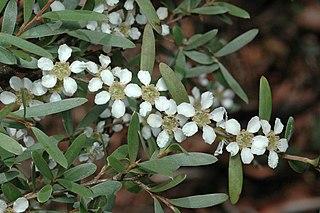
Gaudium polyanthum is a rigid, spreading shrub or small tree that is endemic to New South Wales. It has thin, rough bark, young stems that are hairy at first, elliptical leaves, relatively small white flowers and fruit are shed when the seeds are mature.

Gaudium sericatum is a species of erect shrub that is endemic to Queensland. It has thin, firm bark, narrow egg-shaped to elliptical leaves, white or pink flowers arranged usually singly on side shoots and fruit that falls from the plant when the seeds are released.

Leptospermum sphaerocarpum is a species of shrub that is endemic to New South Wales. It has thin, firm bark, elliptical, sharply-pointed leaves, greenish white or pink flowers and fruit that remain on the plant at maturity.

Gaudium subglabratum is a species of open shrub that is endemic to a south-eastern New South Wales. It has thin, rough bark, egg-shaped to lance-shaped leaves with the narrower end towards the base, white flowers arranged singly on short side shoots and relatively small fruit that falls from the plant at maturity.

Neofabricia mjoebergii is a species of flowering plant in the family Myrtaceae, and is endemic to Cape York Peninsula in Queensland. It is a shrub or small tree with narrowly elliptic, sometimes lance-shaped or egg-shaped leaves with the narrower end towards the base, white or cream-coloured flowers usually borne singly in leaf axils, and broadly conical fruits.



















